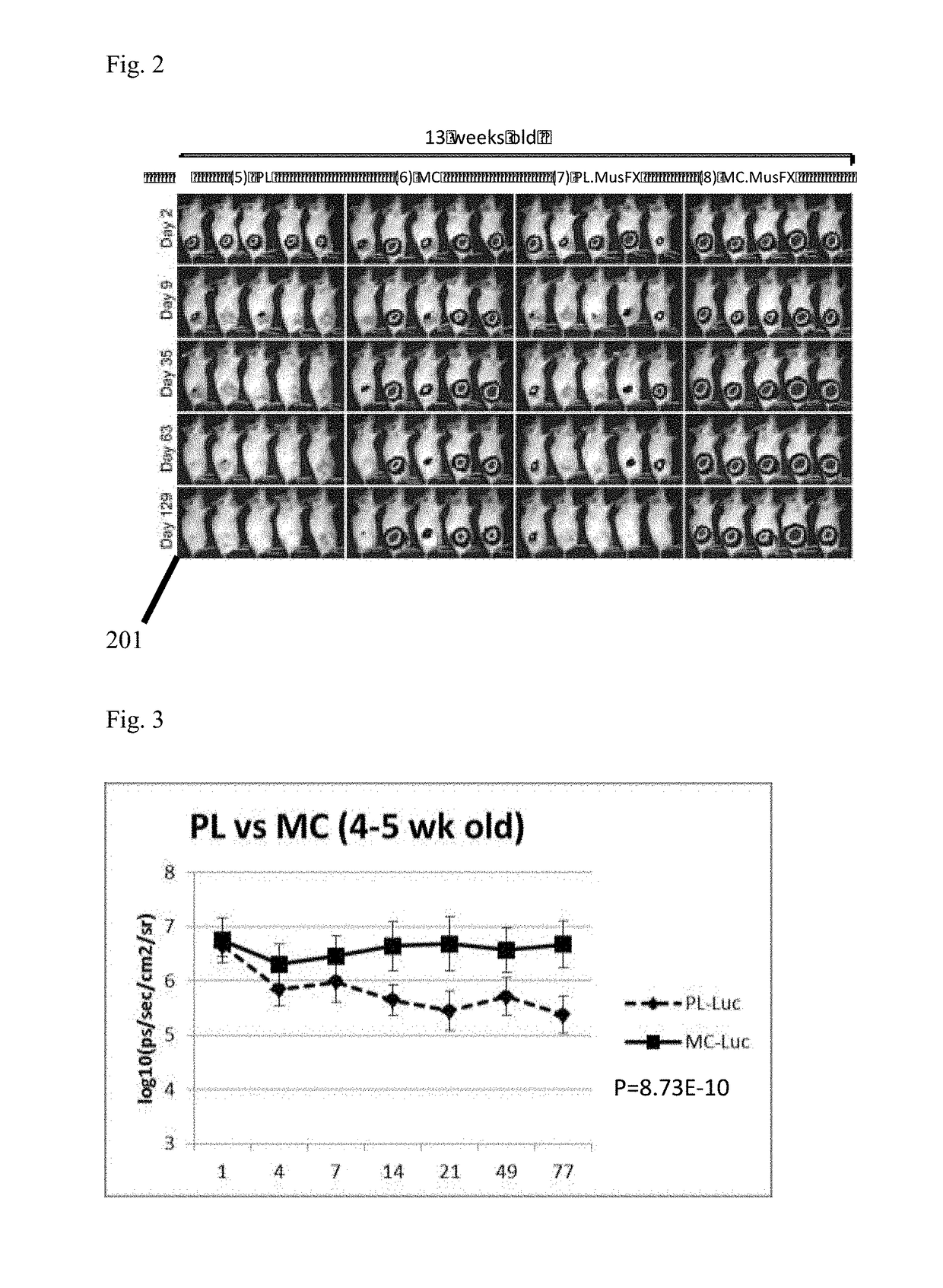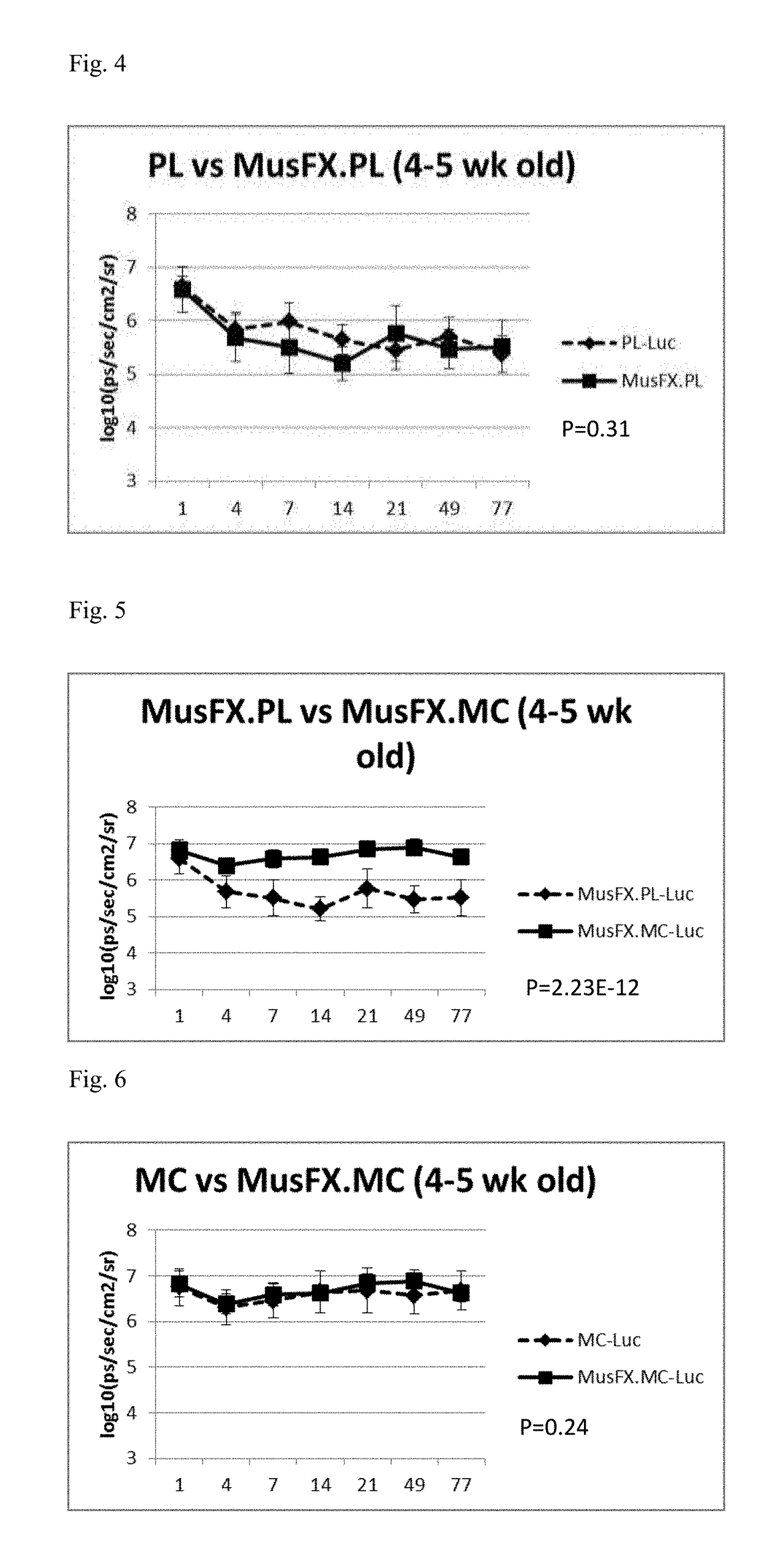Personalized Medicine Therapeutic MiniCircle
a technology of personalized medicine and minicircle, which is applied in the direction of immunoglobulins, peptides, drugs against animals/humans, etc., can solve the problems of limited success of scientific and medical community for over a quarter century, and the inability to successfully administer dna for therapeutic purposes,
- Summary
- Abstract
- Description
- Claims
- Application Information
AI Technical Summary
Benefits of technology
Problems solved by technology
Method used
Image
Examples
example 1
[0030]FIG. 1 is an illustrative biofluorescence image demonstrating plasmid backbone DNA silencing effect in Female BABL / C mice at 4-5 weeks of age. Image panel 101 depicts varying levels of gene expression indicating transfection efficiency by contrasting plasmid (PL), MiniCircle alone (MC), Plasmid with co-transfection agent MusFX (PL, MusFX) and MiniCircle with co-transfection agent MusFX (MC, MusFX). FIGS. 3-6 are graphical depictions charting corresponding differences between gene expression levels of plasmid and MiniCircle in the presence and absence of transfection co-factor Mus.FX at 4-5 weeks. As FIG. 3 clearly illustrates, gene expression levels from transfection of MiniCircle alone result in a clear superiority over transfecting the same gene group utilizing a plasmid vector.
example 2
[0031]FIG. 2 is an illustrative biofluorescence image demonstrating plasmid backbone DNA silencing effect in Female BABL / C mice at 13 weeks of age. Image panel 101 depicts varying levels of gene expression indicating transfection efficiency by contrasting plasmid (PL), MiniCircle alone (MC), Plasmid with co-transfection agent MusFX (PL, MusFX) and MiniCircle with co-transfection agent MusFX (MC, MusFX). FIGS. 7-10 are graphical depictions charting corresponding differences between gene expression levels of plasmid and MiniCircle in the presence and absence of transfection co-factor Mus.FX at 13 weeks. Similar to FIG. 3 in the previous illustrative example, FIG. 7 clearly illustrates gene expression levels from transfection of MiniCircle alone resulting in a clear superiority over transfecting the same gene group utilizing a plasmid vector.
[0032]Gene expression differences between plasmid and MiniCircle transfection are attributable to the plasmid backbone silencing effect. The pheno...
example 3
[0033]In a third illustrative embodiment, MiniCircle efficacy is enhanced by rational engineering of DNA sequences to improve functionality encoded by the MiniCircle DNA sequence. MiniCircle DNA can be used to express traditional bi-specific antibodies (bsAbs) with two scFv. In the illustrative third embodiment, either one or both scFvs are replaced by other elements to bind either target cells or effector T cells, such as natural ligands or synthesized peptides capable of binding receptors; furthermore, the scFv are alternatively replaced by Camel antibody elements, which have a smallest size. In this dual-target application the name of BTEC (bridge between target and effector cells) is used to represent all the formats. BTEC (the Bridge between Target and Effector Cells) is an engineered protein comprising two arms or parts: one arm recognizing target cells, the other arm recognizing effector cells via binding to the molecules on T (or NK) cell receptor signaling pathway. The BTEC...
PUM
| Property | Measurement | Unit |
|---|---|---|
| Therapeutic | aaaaa | aaaaa |
| Hydrophobicity | aaaaa | aaaaa |
| Level | aaaaa | aaaaa |
Abstract
Description
Claims
Application Information
 Login to View More
Login to View More - R&D
- Intellectual Property
- Life Sciences
- Materials
- Tech Scout
- Unparalleled Data Quality
- Higher Quality Content
- 60% Fewer Hallucinations
Browse by: Latest US Patents, China's latest patents, Technical Efficacy Thesaurus, Application Domain, Technology Topic, Popular Technical Reports.
© 2025 PatSnap. All rights reserved.Legal|Privacy policy|Modern Slavery Act Transparency Statement|Sitemap|About US| Contact US: help@patsnap.com



